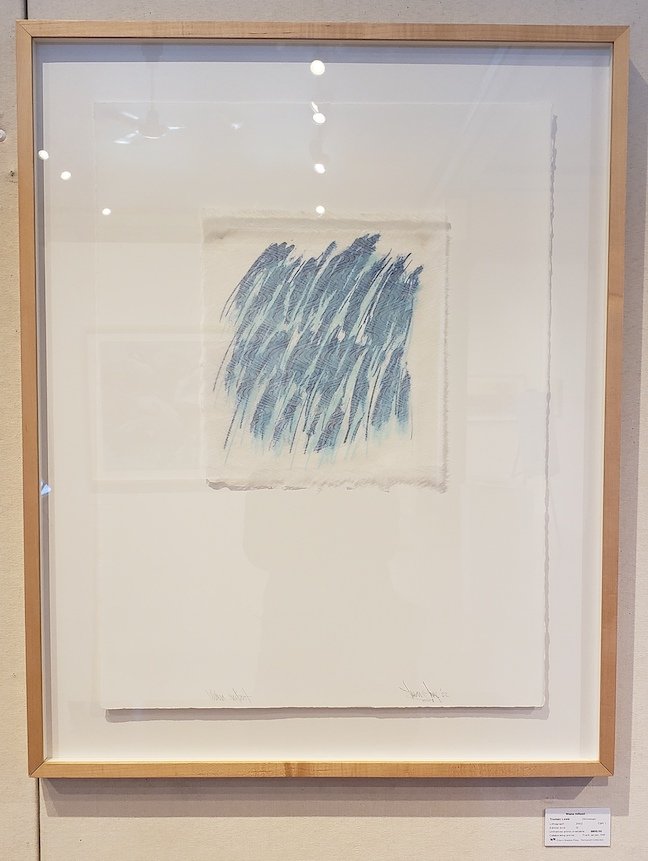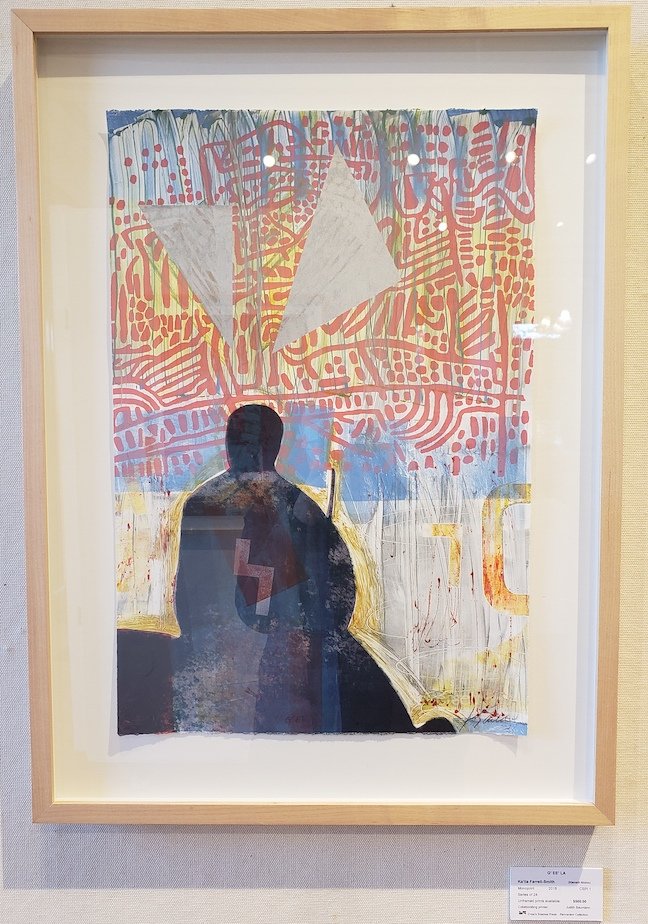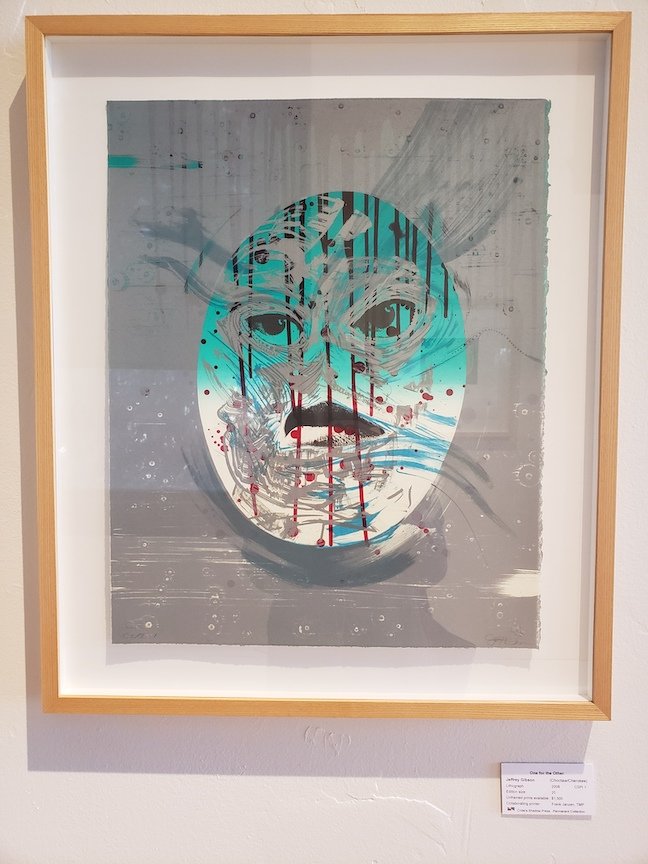TD Art Center Exhibit: Crow's Shadow prints rooted in “Contemporary Native Voices”
Hands-on print making experience offered on Saturday, March 12
Editor’s Note - Here’s a cool opportunity. Participants will be guided through a tour of the gallery on Saturday, March 12th, from 1 p.m. to 4 p.m. with a discussion of printmaking techniques, and a hands-on chance to understand more about the process. Bring your “curiosity and desire to learn about printmaking,” with no previous experience or supplies necessary.
By Sarah Cook
The Dalles Art Center, in conjunction with Columbia Center for the Arts in Hood River, is hosting a collection of prints on loan from Crow’s Shadow Institute of the Arts (CSIA), a gallery and studio space located in Pendleton that showcases and supports Native American artists working at the local, regional, and international level.
Rick Bartow, “Crow Shadow.” Printmaking allows a single plane to capture movement across multiple planes, making a certain kind of visual simultaneity possible. See, for example, this Rick Bartow monoprint, which includes a lithographic image in the center alongside color and textural backgrounds that change with each printed version.
Through their printmaking studio space and Artists-in-Residence program, Crow’s Shadow hosts between three and six artists each year, who come to Crow’s Shadow Institute to learn the printmaking process and develop their own series of work. The world of printmaking includes subtle differences in technique; prints can take the form of lithographs, linocuts, woodcuts, monoprints, and monotypes (to name just a few), any and all of which are produced by the artists working at Crow’s Shadow studio. These techniques lead to limited-edition prints with slight differences in, for example, color, background, or texture, creating a world of unique but interconnected images, tethered both visually and emotionally to each discrete version.
This sense of relation and bridging is reflective of the overall mission of Crow’s Shadow, which is to “provide a creative conduit for educational, social, and economic opportunities for Native Americans through artistic development.” Formed in 1992 by local artists James Lavadour (Walla Walla) and Phillip Cash Cash (Cayuse and Nez Perce), the place-based and culturally informed artwork coming out of their two-week residency program can be found in major art collections all over the country, including at the Library of Congress, the Museum of Fine Arts Boston, and the Whitney Museum of American Art.
From the CSIA website: “Crow’s Shadow has grown in both art world stature and programmatic vision, expanding its locally based, service-oriented mission to its current iteration, national in scope.” Many of the artists-in-residence at the Crow’s Shadow studio are without printmaking experience when they arrive, meaning the technical expertise gained through the program “allows them to realize a project in a media that they would not otherwise be able to accomplish.” The opportunity to work alongside a Master Printer, a role currently filled by Judith Baumann, facilitates the evolution of each artist in their creative journey. Besides providing the artists with new and expanded techniques, CSIA helps market and sell their work, retaining one example from each series for their permanent collection, which now holds more than 200 prints by more than 45 artists.
Looking at the selection currently on display at the Art Center, one is pleasantly overwhelmed by an interwoven sense of both medium and time. CSIA artists have experience in fields like sculpture, woodblock carving, installation and quilting; spend time with the prints on display and you’ll begin to notice a diversity of texture and perspective that reads as a direct result of cross-genre artistry, of artists simultaneously rooted in their unique history of skills while expanding their visions through a new art form. Additionally, the oldest print I register, a delicate and watery lithograph created by artist Truman Lowe—is from 2002, born out of Crow’s earliest artist residency days.
Truman Lowe, “Wana mitaat”
The dynamic nature of the printmaking process—which can include woodcuts, a relief printing technique, as well as collography, a versatile process that involves layering ink on textured plates—creates a heightened awareness of surfaces. As a viewer, I am perhaps not always consciously thinking about the physical surface that exists between myself and whatever piece of art I’m apprehending: I’m thinking about content, or I’m noticing color, or I’m considering meaning, either directly or subconsciously. But with printmaking in general, and this current exhibit specifically, it becomes impossible to ignore the material conditions of art-making. There are moments where, elevated by the presence of multiple layers of ink, the exterior of an image suddenly shifts to its interior or vice versa. It’s as if printmaking allows for a single plane to capture movement across multiple planes, making a certain kind of visual simultaneity possible. Because of this, the surface can be beguiling, a momentary place to rest my eyes along their journey more so than an objective place to stop.
Ka’ila Farrell-Smith, “G’ EE’ LA”
Surface becomes more than just a point of contact between yourself and the image, which is what I come to understand as I orient myself alongside the prints on loan from Crow’s Shadow. Consider all the things that arise inside of you when engaging with art: ideas and feelings at once relevant, mundane, a little too on-the-nose at times, or utterly beside the point. I try to return to the basics: I look at a print and I see teal, except it’s not teal, it’s a little brighter. Now I see what looks like wind becoming water, though I’m not completely sure that’s the right order. Now I’m remembering a loved one. All of it enters the frame and contributes to the depth of field, which expands to include the context of me alongside the context of the art form—in this case, the layers of ink, the transferred images, and the other surfaces, made of wood or glass or metal, that have created impressions on the surface before me.
Jeffrey Gibson, “One for the Other”
Because the work on loan at the Art Center spans the entire 20+ year history of Crow’s artist residency program, a sense of evolution is on clear display in this exhibit, both amongst the collective and within individual artists. But the relationship between an artist’s evolution and the passing of time isn’t always a measurable one. I find myself moved by two wildly different images made by artist Yatika Starr Fields. One, from his “Sun Carrier” series, is a chaotic and exuberant image that seems to revolve around a sculptural, personified sun. The other, “Miles & Maude,” is a sweet and comparatively simpler image of two cats, each one turned away from the viewer. With a focus more direct than the first image, this one conveys a surprising amount of depth. I assume it might’ve been made a handful of years prior to “Sun Carrier” piece. But when I look for the dates of completion to see if I’m correct, I find that both pieces were completed in 2019. Inspired by the artist’s depth of interests, I visit his website and learn that both spontaneity and graffiti aesthetics are integral to his art-making process.
Yatika Starr Fields: one from the “Sun Carrier” series.
Yatika Starr Fields: “Miles & Maude”
In line with the comprehensive and dynamic spirit of the Crow’s Shadow mission, the exhibits at both the Art Center and Crow’s Shadow Institute are being accompanied by multiple opportunities for in-person and online experiences of live art, learning and demonstration.
The first took place in late February with a free performance by musician James Edmund Greeley of the Confederated Tribes of Warm Springs, whose 2017 album, Before America, won “Best Traditional Recording” through the Native American Music Awards.
Next in the series of events will be a print demonstration with Maggie Middleton, who serves as assistant to the Master Printer at Crow’s Shadow on March 12th., from 1 p.m. to 4 p.m. at The Dalles Art Center.
Last in the series, will be a Crow’s Shadow Artist Talk, an online webinar taking place on Tuesday, March 15th at 4 p.m. on Zoom, featuring the current Crow’s Shadow Executive Director, Karl Davis, along with featured artists Lillian Pitt, John Feodorov, Marwin Begaye, Natalie Ball, and Joe Cantrell.
The Dalles Art Center is at 220 E. 4th Street. It’s open Tues. - Sat., 11 a.m. to 5 p.m.; there is no admission fee, donations are accepted and directly support the continuation of their work.






